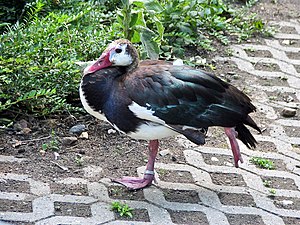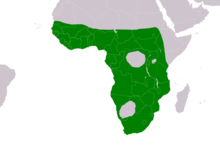Spurge Goose
| Spurge Goose | ||||||||||||
|---|---|---|---|---|---|---|---|---|---|---|---|---|

Spurge Goose |
||||||||||||
| Systematics | ||||||||||||
|
||||||||||||
| Scientific name of the genus | ||||||||||||
| Plectropterus | ||||||||||||
| Stephens , 1824 | ||||||||||||
| Scientific name of the species | ||||||||||||
| Plectropterus gambensis | ||||||||||||
| ( Linnaeus , 1766) |

The spur goose ( Plectropterus gambensis ), more rarely also referred to as the spore goose , is a long-legged glossy duck that is distributed over almost all of Africa with the exception of North Africa .
Sporn geese with geese and half geese used. However, they differ in a number of anatomical peculiarities and are therefore occasionally placed in their own subfamily called Plectropterinae. The grouping in the tribe Plectropterini, in which it is placed together with the humped goose , was based on similarities in behavior. In addition, there are significant differences in size between the sexes in both species.
Appearance
Spurge geese get their name because a spur is formed on each wing bend. Male spur geese are significantly larger than the females. They weigh an average of 5.5 kilograms. They also have a more developed red beak-forehead hump. Old spur ganters also have bare red skin on the sides of their necks.
The two subspecies differ in the division of the black and white body plumage. P. gambensis gambensis has a white belly and white flanks. The subspecies P. gambensis niger , which is distributed south of the Zambezi , has only a small white belly spot.
When young, spur geese already show the same black-and-white distribution as adult birds. However, the feathers of these not yet sexually mature geese are highlighted in brown and do not shine as much as in the adult geese.
distribution and habitat
Both subspecies have a large distribution area within Africa. As a bird species that is bound to the water, there is a decline in populations in regions that have experienced dry seasons in recent years. In South Africa, the species benefited from the reservoirs that were created in agricultural regions.
Spurge geese inhabit extensive swamp plains, large rivers, inland lakes and reservoirs rich in vegetation in the savannah regions and agricultural zones. Their diet consists of green parts and seeds of numerous marsh and aquatic plants.
The beginning of the breeding season depends on the respective rainy season. The nest is very simple. It mainly consists of a deep nest hollow that the female scratches. The nesting area is defended aggressively. The wing spur is also used here.
A clutch consists of six to ten eggs on average. They are smooth-skinned and cream-colored. The chicks hatch after an incubation period of 30 to 32 days. According to previous observations, chicks are looked after exclusively by the female.
Toxicity
The barnacle goose is one of the few poisonous birds . This is due to the fact that it eats beetles from the oil beetle family (Meloidae), which contain cantharidin . This enriches them in their tissues , so that consumption, depending on the amount of beetles ingested, is poisonous for predators and humans.
Individual evidence
- ↑ Kolbe, p. 133
- ^ Stefan Bartram, Wilhelm Boland: Chemistry and ecology of toxic birds. In: ChemBioChem 2, No. 11, November 2001, pp. 809-811, doi : 10.1002 / 1439-7633 (20011105) 2:11 <809 :: AID-CBIC809> 3.0.CO; 2-C .
- ↑ Karem Ghoneim: Cantharidin toxicosis to animal and human in the world: A review. ( Page no longer available , search in web archives ) Info: The link was automatically marked as defective. Please check the link according to the instructions and then remove this notice. In: Standard Res. J. Toxicol. Environ. Health Sci 1, 2013, pp. 001-022.
literature
- T. Bartlett: Ducks And Geese - A Guide To Management. The Crowood Press, 2002, ISBN 1-85223-650-7 .
- Hartmut Kolbe: The world's ducks. Ulmer Verlag 1999, ISBN 3-8001-7442-1 .
- Josep del Hoyo , Andrew Elliott, Jordi Sargatal (eds.): Handbook of Birds of the World . Volume 1: Ostrich to Ducks. Lynx Edicions, Barcelona 1992, ISBN 84-87334-10-5 .
Web links
- Videos, photos and sound recordings of Plectropterus gambensis in the Internet Bird Collection
- Plectropterus gambensis in the Red List of Threatened Species of the IUCN 2013.1. Listed by: BirdLife International, 2012. Retrieved September 22, 2013.
